Banknotes and coins, marks, dollars, zlotys, and even occupation "millers" and "rumki" from the Lodz ghetto. Any currency can be counterfeited. Before the war, crooks and fraudsters dealt with this. During it - literally everyone, led by the Home Army.
There is no "them"! Freedom! Independence! Union! Own state! Forever! (...) Four generations waited in vain for this moment, the fifth lived to see - was written in November 1918 by the Galician politician Jędrzej Moraczewski.
The joy of the rebirth of an independent state, however, did not stop many "enterprising" citizens from taking advantage of the chaos prevailing in the country. The fact that several currencies were in circulation favored the money scams.
Independent in captivity for counterfeiters
As early as January 1919, the Ministry of the Interior was informed that counterfeit 1000-mark banknotes had appeared. A month later, they were also joined by smaller denominations. In this case, it must be admitted that the power itself made the frauds' lives easier, because the originals were made in an extremely primitive way. Nevertheless, the counterfeits could be identified by the different paper, uneven print, shapeless outlines of the letters and other ornamentation.
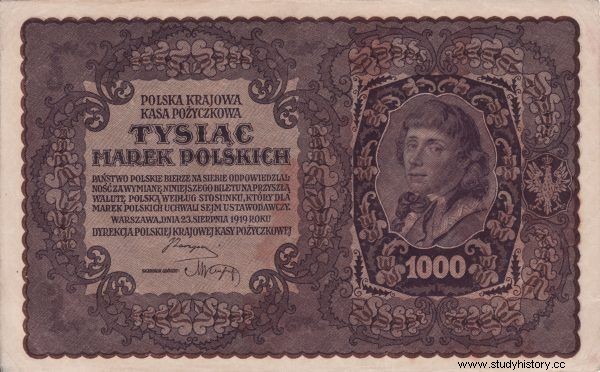
From the moment of regaining independence, a lot of counterfeit banknotes circulated in the Second Republic of Poland, including 1000-brand ones, i.e. with the highest denomination (source:public domain).
Not only Polish brands were faked. In 1922, several people from Toruń, Grudziądz and Wąbrzeźno were arrested for counterfeiting and circulating ... 100-dollar banknotes.
To protect themselves against counterfeiters, the authorities introduced better security measures in August 1919. But when inflation and hyperinflation came, it became more difficult to maintain the quality of the banknotes that were issued. Both the state and counterfeiters began to print larger and larger denominations.
When the currency reform and stabilization of the Polish zloty were successfully carried out in 1924, the number of counterfeits detected dropped, but not all fraudsters gave up. They even expanded their assortment! They also started to counterfeit the coins which was less profitable but was much easier . There was no need to look for the right paper and ink or think about how to plot complicated patterns on the banknote, how to skillfully age it and how to get a watermark.
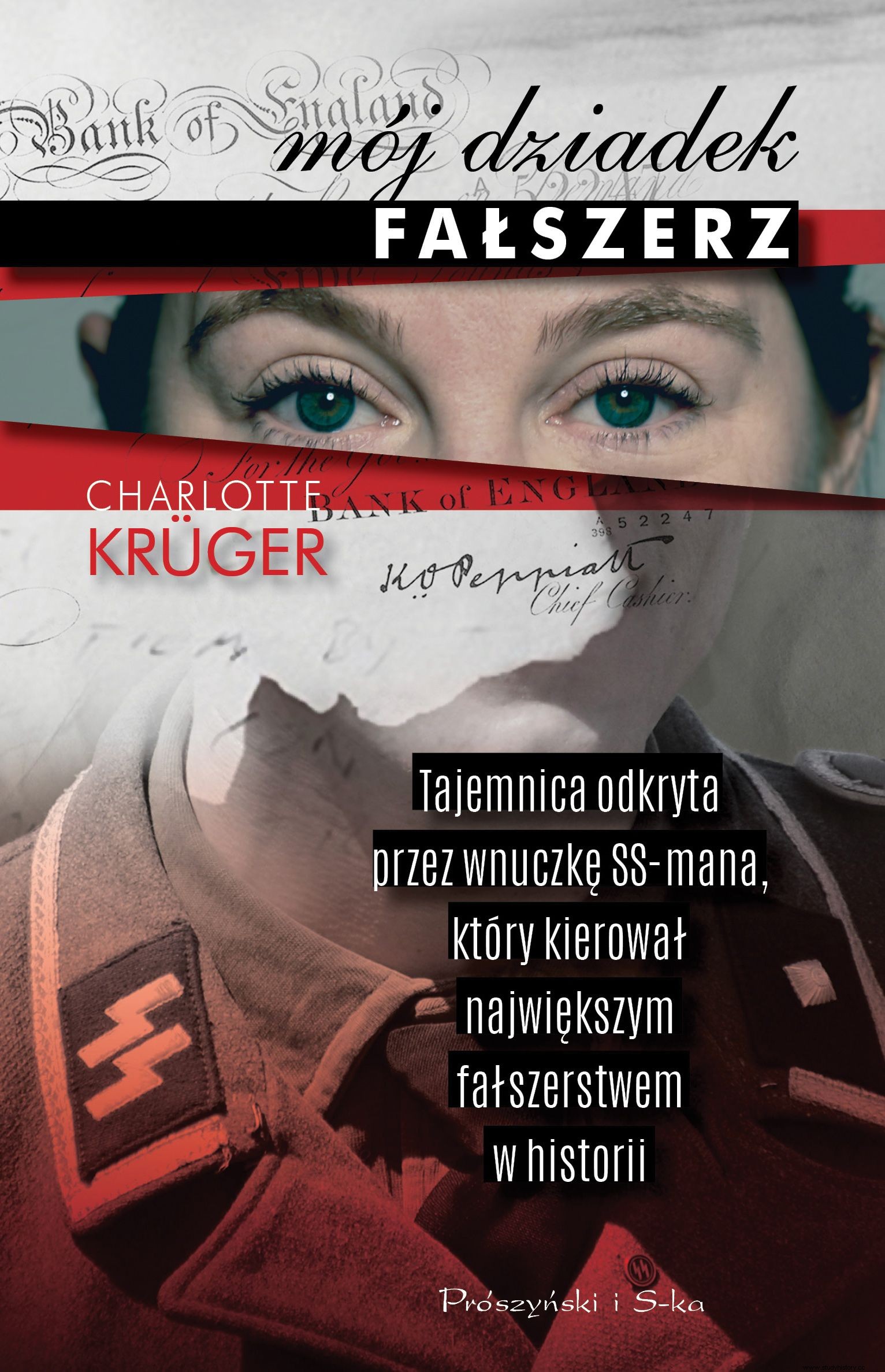
The article was based on, among others, the book by Charlotte Krüger "My grandfather falser", which has just been published by the Prószyński i S-ka publishing house.
Pennies from Christ's feet
Only a few items were enough to make your own coin:a stove, a crucible for melting metals, a spoon for pouring molten metal, a chisel to make cuts around the circumference of the coin, and plaster for making the casts of the coins. Some also used an iron stamp and a press. The only problem was to choose the proportions so that the final product had the right weight. Usually lead, tin, brass and antimony were mixed together.
In 1925, three fraudsters from Lodz - Bugzel, Pruc and Fisjak - took up a rare, but not very profitable practice. They started to counterfeit ... nickel-plated coins with a face value of 50 groszy. They were produced - as the Lodz press indignantly reported - with feet taken down from the cross of Christ . The noble origin of the material did not help. The product was so poor that the crooks were exposed by the Łódź hawkers .
Counterfeit coins were usually easy to spot. They had a different weight, a dull shine, made a hollow sound, and felt greasy. They lacked proper polishing, patination or silver plating. To check the authenticity of the coins, it was also possible, in case of doubt, to use the small and easy-to-use scales offered by many stores. However, the fraudsters were not discouraged:the 5-zloty coin from 1926 was counterfeited so often that it was withdrawn from use.
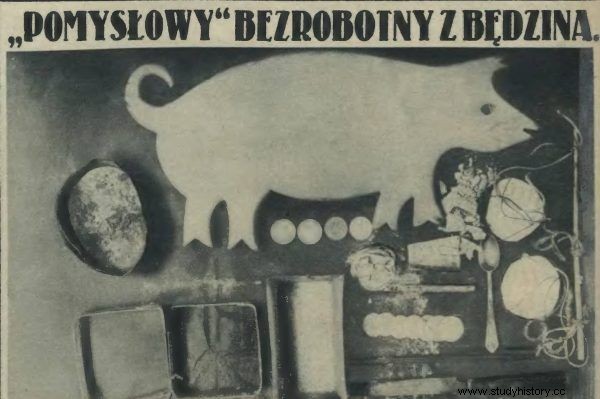
The press frequently reported on further cases of counterfeiting. The "Secret Detective" even posted a photo of the "workshop" of an unemployed person who produced 1-zloty and 50-cents coins on his own (source:public domain).
Every now and then the police caught people trying to introduce fakes into circulation. In 1931, officers from Łódź could boast of a particular success. As reported by "Dziennik Łódzki" in an article under the sensational title "Falsificates of 20 zlotys on the naked body of a colporteur":
An elegantly dressed woman was arrested (...) in front of the Municipal Theater, circulating fake 20 zloty banknotes. So far, no counterfeits have been found in the detainee, while during the search, fake 20 zloty banknotes were found on the naked body of the woman, skilfully attached to her underwear.
End of business for Messrs Tomczyk and Lewandowski
In Poland, the Criminal Office of the Headquarters of the Investigative Service dealt with the fight against the illegal production of money, checks, securities and foreign passports. The policemen had their hands full. In 1935, 27,000 counterfeit money was detected within 10 months! And even when their source was found, new ones were created in place of the liquidated factories.
The police recorded two major successes in 1933. The "producer" of 20-zloty banknotes and the "manufacturer" of silver 10-zlotys were arrested. He was the first to come when the police noticed that cashiers of very good quality at the Main Railway Station in Warsaw were used as the rest. The policemen found out that they got them from one of the porters, who sold them for PLN 5 apiece .
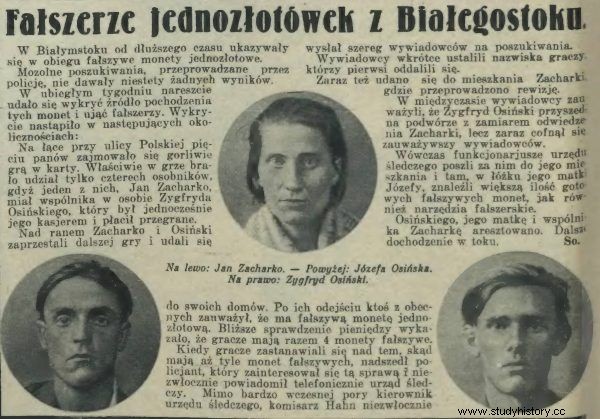
Newspapers such as "Secret Detective" published images of fraudsters caught counterfeiting money, reporting on the success of the police. In Białystok, we managed to break the gang of counterfeiters of single-zloty coins (source:public domain).
Police observation revealed that the porter was getting counterfeit banknotes from a match seller in front of the station. He took them directly from the producer, a certain Tomczyk from Ogrodowa Street. Similarly, thanks to the capture of one of the coin dealers, the police managed to reach the "mint" on Twarda Street, which was run by a certain Lewandowski.
In the same year, 1933, a group led by Lawartowski, Kajęcka and Matusowa also came by, As reported by "Nowiny Codzienne", they intended to deliver a false 5-zloty and 10-zloty coin to the parliamentary coffers for the payment of parliamentary salaries. The rogues fell in thanks to the honesty of a parliamentary official who apparently agreed to take the coins and put them into the cash register, but in fact notified the police.
An interesting case was the trial of a man called Myślicka, who was distributing counterfeit 5-zlotys, described in "Dziennik Morning", who was brought to trial at some point ... got up from the bench and began to sing "Who's looking after" . She claimed that she was going to the procession and tried to leave the hall. She also tried to feel pity for the judgment by saying My children are hungry! Perhaps that is why the sentence was quite favorable:only 1.5 years in prison.

The article was based on, among others, the book by Charlotte Krüger "My grandfather falser", which has just been published by the Prószyński i S-ka publishing house.
War ... on banknotes
During World War II, large-scale falsification was undertaken by ... the Nazis. The production of counterfeit British pounds, American dollars and other currencies was supervised by SS-Hauptsturmführer Bernhard Krüger. The operational center was located in the Sachsenhausen camp. The enterprise was named after its commander:"Operation Bernhard".
Krüger, who had so far dealt mainly with radio telegraphy, was surprised that he was assigned such a task. However, he handled it brilliantly. He assembled a team of professionals who produced such successful money that after the war the British withdrew from use all the 5- and 10-pound notes .
They suspected that almost half of them are not original! German fakes were almost indistinguishable from real money. It was possible to recognize them only thanks to the lack of correlation of the numbers printed on the counterfeits - the dates of production of the paper and the banknote.
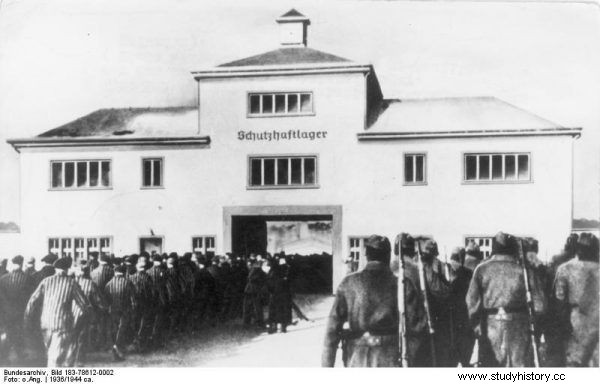
The operating center of the biggest forgery during the Second World War was ... the concentration camp in Sachsenhausen. Prisoners were used to counterfeit pounds and dollars. The action was commanded by SS-Haupsturmführer Bernhard Krüger (source:Bundesarchiv, license CC BY-SA 3.0 de).
In order to achieve such an effect, Bernhard Krüger, whose story is described in the book "My grandfather forger", had to overcome not only the problem of securing money, but above all the "employee" issue:
Take control of prisoners, who became disgraced, disgraced beings human, did not require any special character traits. Reconciliation them, encouraging and kidnapping them to the effort that runs counter to their beliefs, their sense justice and the notion of dignity, however, required frome me to gain their trust. To achieve the intended goal, I couldn't stand up and shout:"I trust you, so you do me trust! » (…). The prisoners would not believe a single word of mine. Me, with an eagle on the sleeve of the sweatshirt and a skull on the cap. What at most they would consider me a complete idiot.
(Counterfeit) Swastika Grinders
Money was also counterfeited in occupied Poland. Part of the production was intended for personal use, because petty fraudsters did not cease their activities, but the currency was also counterfeited ... for the use of the Home Army. Within its framework, the PWB-17 group (Podziemna Wytwórnia Banknotów) was active, the members of which worked at the National Security Printing Works in Warsaw.
It dealt with, with the consent of the emigration authorities, copying the millers , i.e. banknotes issued by the Bank of Poland subordinated to the German authorities in the General Government. Their name comes from the name of the Bank's director, Feliks Młynarski.
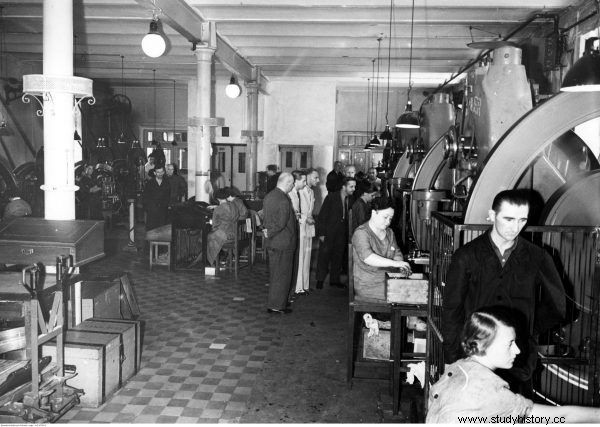
The Polish authorities under the occupation could only dream of such equipment for the production of coins ... In the photo, the State Mint in Warsaw (source:public domain).
The conspirators smuggled materials needed for the production of banknotes outside the plant. The group members replaced packages of less successful copies of the money produced with originals. Counterfeit products were reported as unsuccessful prints, destined to be destroyed by a committee. By the end of the operation, that is, by the end of 1942, the Polish Underground State thus obtained 18 million zlotys.
Counterfeit milling machines were also produced in Great Britain. Most often they were banknotes in denominations of 50 and 500 zlotys, called "highlanders". They were delivered to Poland together with airdrops from mid-1943. However, they were quite flawed, because the British did not know the secrets of the chemical paint and the paint wiped off over time.
"Legalization", i.e. replacement with originals, was usually performed by employees of local banks. It was not completely safe. The mishap occurred, for example, in Piotrków, where patriotic fraudsters were arrested by the Gestapo.

The article was based on, among others, the book by Charlotte Krüger "My grandfather falser", which has just been published by the Prószyński i S-ka publishing house.
Only millers were not taken care of. Pre-war 100-zloty banknotes with Prince Józef Poniatowski were also legalized. In the first months of the occupation, they were admitted to trading if they had German overprints confirming their validity. The counterfeiters decided to help their countrymen and simply… prepared their own stamps with the inscription "Generalgouvernement für die besetzten polnischen Gebiete" (General Government for the occupied Polish territories). Thanks to them, it was possible to seal banknotes kept at home for a small fee.
Fake rum from Lodz and zloty from Moscow
Even rumki, the currency functioning in the Łódź ghetto, named after the head of the Jewish administration of the ghetto, Mordechaj Chaim Rumkowski, did not protect themselves against counterfeiting. They were illegally produced by, among others, Moszek Szymon Rauchwerger.
Before he was caught, he created over 5,000 2-mark banknotes! He was sentenced to heavy prison and a fine. Although you can sometimes find information that Rauchwerger ended up in Sachsenhausen, in fact two other inhabitants of the Łódź ghetto, Seweryn Tiefenbach and Noah Jabłocznik, were in the group that produced "genuine" pounds and dollars.
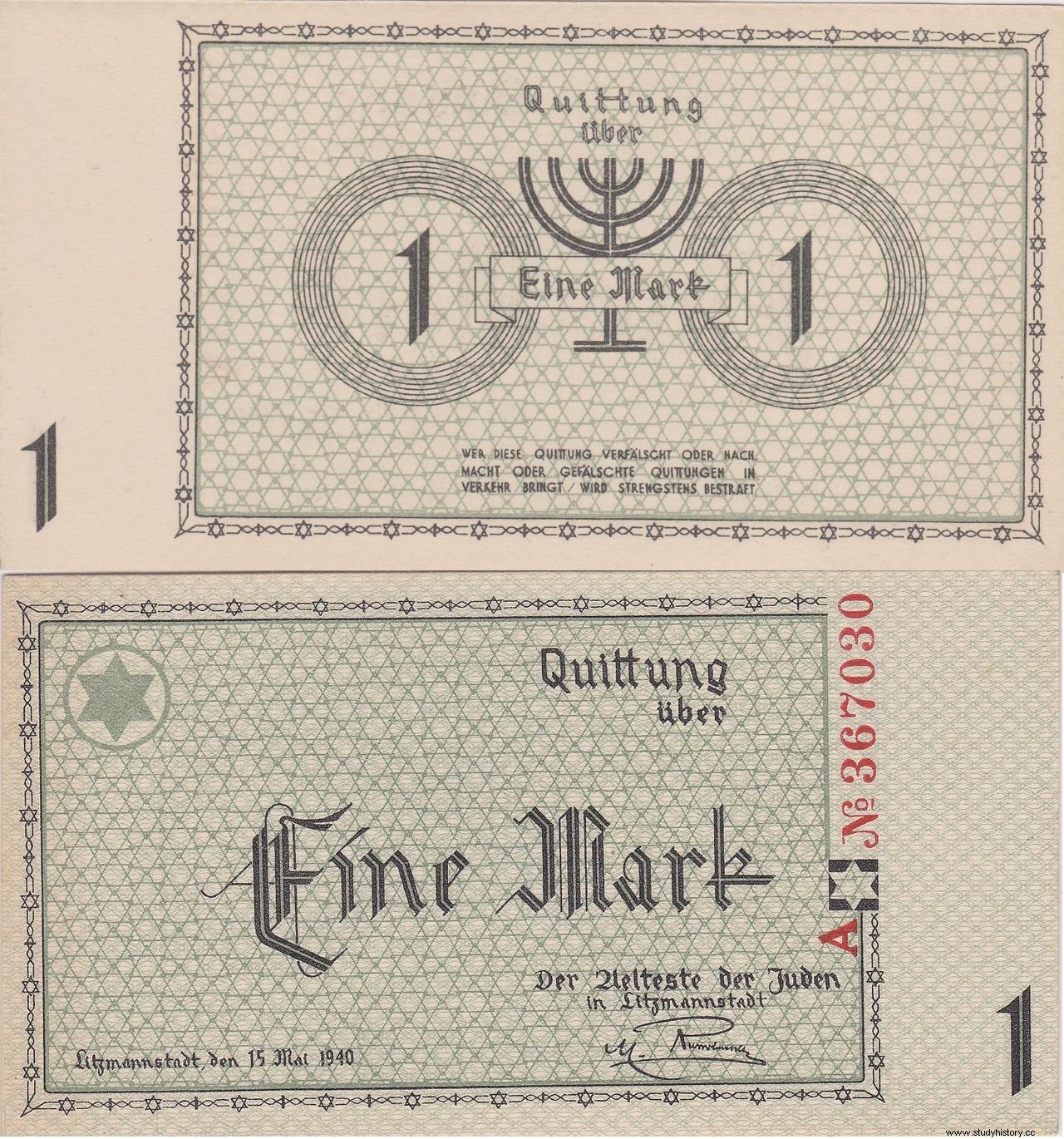
Rumki, i.e. branded receipts, which were the currency of the Łódź ghetto, were counterfeited, among others, by Rochwerger. Before he came up, he had produced over 5,000 banknotes! (source:public domain).
The banknotes of the Lublin authorities from 1944 turned out to be easy to manufacture. Those prepared in Moscow did not have effective safeguards. No wonder that the highest nominal 500 zloty banknote was just after its introduction into circulation, copied on their own as many as 27 szajek ! When the 1000-zloty banknote of equally poor quality was introduced in September 1945, only in the first 6 months one of the "producers" managed to put into circulation over 100,000 of its counterfeits.
Even today, when Polish money is well secured, there is no shortage of attempts to generate it on our own. Each year, several thousand counterfeit coins and banknotes are detected. Interestingly, also ... pre-war coins are also counterfeited due to their collector's value.
Bibliography:
- Andrzej Borowicz, Counterfeiting of coins and banknotes in the 20th century , Bydgoszcz Monetarium.
- Natalia Grabowska, Counterfeit money - a deal not new at all , "Kortowski Przegląd Prawniczy" No. 3/2015.
- Marta Grzywacz, Operation Bernhard, "Ale Historia", supplement to "Gazeta Wyborcza", October 28, 2013.
- Krzysztof Halicki, Forgeries of money in Poland in the interwar period , "Problems of Criminalistics" No. 266, 10-12.2009.
- Włodzimierz Kalicki, Left beat. Conversation about counterfeiting and counterfeiting money with Lech Kokociński, founder and honorary president of the Polish Numismatic Society , "Duży Format", supplement to "Gazeta Wyborcza", January 31, 2005.
- Charlotte Krüger, My grandfather forger , Prószyński i S-ka 2017.
- Lawrence Malkin, Counterfeiters. How the Nazis tried to ruin the British Empire, World of Books 2008.
- Zbigniew Nestorowicz, Counterfeit coins and banknotes of the interwar period , Gems &Jewelery No. 2, October 2014.
- Remigiusz Piotrowski, Absurdities and Curiosities of Pre-War Poland, PWN 2016.
- Francis Russell and the editorial team of Time-Life Books, War of the interviews, Amber 1997.
Buy a book about the greatest forgery in history at Empik.com:

